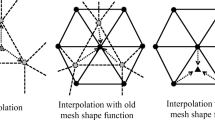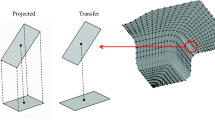Abstract
Due to steadily increasing demands on the die forging industry, process simulation is of continuous importance. The Finite Element Method (FEM) is frequently used to simulate forming processes for the purpose of optimising the quality of the final product and predicting the loading on the tool. Most forgoing processes reduce the original height of the workpiece by 60–70%. Therefore, considerable distortions of the finite element mesh occur and some elements can even degenerate. Consequently, the results obtained are unreliable and sometimes it is impossible to pursue the calculation any further. In order to continue the analysis, it becomes necessary to define a new mesh during the FE-simulation (remeshing). The loss of volume of the new mesh is a very critical point. In this paper an algorithm to mesh complex 3D geometries with tetrahedron elements (FORM TET) is presented, which is taking into account the specific aspects of metal forming processes and increases the loss of volume in FE-analysis. This algorithm creates a mesh that meets the requirements of the object. As illustrated in the presented examples, the elaborated strategy ensures a robust and efficient meshing scheme. To verify the efficiency of this remeshing concept some fundamental metal forming processes have been simulated.
Zusammenfassung
Die Prozesssimulation nimmt einen immer größeren Stellenwert im Hinblick auf die Steigerung der Konkurrenzfähigkeit der Umformindustrie ein. Die Finite Elemente Methode (FEM) wird zur Simulation von Massivumformprozessen verwendet. Hierdurch wird sowohl eine Optimierung der Qualität des Fertigproduktes als auch die Vorhersage der Werkzeugbelastung während der Umformung ermöglicht. Häufig werden bei Schmiedeprozessen die Werkstücke um 60–70% ihrer Vorformhöhe reduziert. Hierdurch entstehen während der Simulation stark verzerrte Netze. Da sich mit zunehmender Elemmentverzerrung die Qualität der Lösung verschlechtert bzw. keine Lösung erzielt werden kann, ist es erforderlich, ein neues FE-Netz während der Simulation zu erzeugen (remeshing). Der Werkstofffluss während der Umformsimulation kann aufgrund des mit der Neuvernetzung einhergehenden Volumenverlustes nicht genau wiedergegeben werden. In diesem Artikel wird ein Algorithmus zur Vernetzung von komplexen 3D-Geometrien mit Tetraeder-Elementen (FORM TET) vorgestellt. Dieser Vernetzungsalgorithmus berücksichtigt die Besonderheiten bei der FEM-Simulation von Massivumformprozessen und verringert den Volumenverlust bei der Neuvernetzung auf ein Minimum. Weiterhin werden die veränderten Anforderungen der entstehenden Zwischengeometrie berücksichtigt. Die Robustheit und die Effizienz dieses Remeshingkonzeptes wird an fundamentalen FEM-Simulationen der Massivumformung illustriert.
Similar content being viewed by others
Author information
Authors and Affiliations
Additional information
Received: 13 January 2000
Rights and permissions
About this article
Cite this article
Doege, E., Meinen, J. Specific features of FE-meshes for the analysis of metal forming processes. Forsch Ingenieurwes 66, 40–48 (2000). https://doi.org/10.1007/s100100000035
Issue Date:
DOI: https://doi.org/10.1007/s100100000035




